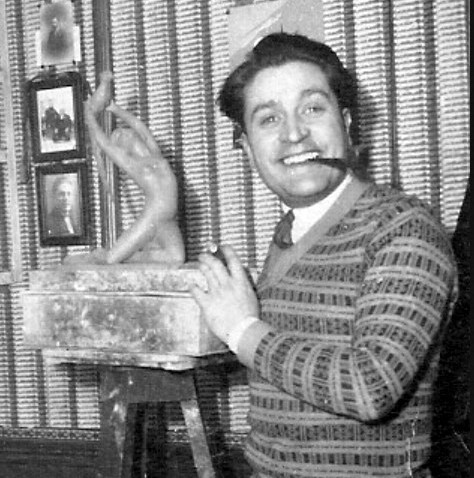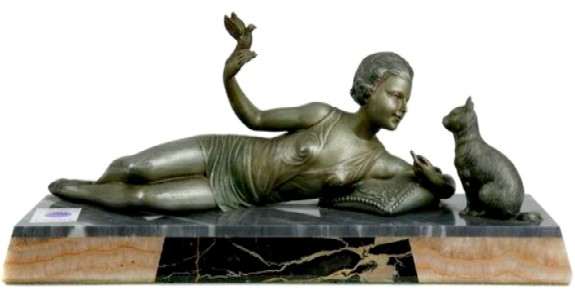
Joan Salvadó i Voltas (1890-1976)
Joan Salvadó was born in Vila-seca, Catalonia Spain.

Joan Salvadó i Voltas, Nude Sculpture, Probably 1920s-30s, Biblioteca de Vila-Seca
His interest in art was first noticed at age 14 when he began drawing studies for sculptures while working as an apprentice in the workshop of a sculptor in Reus. Reus was a thriving cultural center featuring modernist architecture. It is possible that architect Antoni Gaudí was born in Reus, although he might also have been born in nearby Riudoms. So Joan would have been exposed to the new Modernist style at an early age.
Salvadó moved to Barcelona where he studied Fine Arts and worked on the Sagrada Família church. He sculpted several works under the watchful eye of Antoni Gaudí. His sculpture of an angel three meter tall angel called The Annunciation was considered the most significant sculpture he created for Gaudí. Unfortunately, all of Salvadó's work for Gaudí disappeared during the Spanish Civil War that began in 1936 when a group of anarchists broke into Gaudí room, smashed his models and burned his architectural drawings.
Later, likely during the 1920s, Salvadó moved to Paris, the mecca for the new style of art which would later be called Art Deco. Here, he learned to carve ivory and to goldsmith. He began producing sculptures of women, often nude or in states of partial undress in the style that is now referred to as Art Deco. His sculptures typically featured rounded oval faces and short hair or form-fitted hats. They frequently appear with animals. These sculptures are signed 'J Salvado'.
Salvadó returned to Vila-seca, Spain shortly before the Civil War of 1936. His training in Paris helped him to become a restorer, specializing in Gothic art. He began restoring sculptures in the chapel of the baptistery of the Tarragona cathedral. While working in Paris, he sculpted small

Joan Salvado, Woman with Bird and Cat, Metal Sculpture on Marble Plinth, 1920s-30s, Lot-Art.
and medium-sized sculptures in Art Deco style. In his home country, he began specializing in large religious figures. St. Peter's Church of Barcelona commissioned him to make a sculpture of The Return From Calvary, featuring the Virgin Mary, St. John, Mary Cleopatra and Mary Magdelene. The Virgin and John were completed for St. George's Day of 1941 with the final two statues being finished in 1944. (See 'Les Confrares' on the Setmana Santa TGN website.) He created a wide variety of other religious statues in Spain many of which can be seen on this website.
There is also evidence that he taught his artistic style to others, although it is not clear whether this was done in formal schooling or apprenticeships. One website reports, "Jordi Sarrà Rabascall (Vila-seca, 1935 – Reus, 1990). Painter. In 1944 he received the first drawing lessons of the sculptor Joan Salvadó Voltes." (Disputacio Tarragona website) The way this is written sounds as if Jordi was an apprentice.
In September of 1977, the Vila-seca Town Council sponsored a tribute exhibition with the many local artists participating. A street has been named after him in Barcelona ('Carrer de Joan Salvadó i Voltas', Callejero.club) which makes it most interesting that there is so little information about his life is available on the internet.
Other Sources Not Mentioned Above:Art Nobel
Brightside Tours
Original Facebook Group Posting
 Joan Salvadó Art Deco Style Sculptures, From Left: Woman Holding a Bird with Ball Lamp, Nickel-Plated Bronze on Yellow Marble Plinth, c 1925, Sapphire Prime Collectibles; Figural Lamp, Egyptian Dress, Patinated Metal on Green Marble, 1920s-30s; Woman with Deer, Patinated Brass on Marble Plinth, 1920s - 30s, Proantic. -
Joan Salvadó Art Deco Style Sculptures, From Left: Woman Holding a Bird with Ball Lamp, Nickel-Plated Bronze on Yellow Marble Plinth, c 1925, Sapphire Prime Collectibles; Figural Lamp, Egyptian Dress, Patinated Metal on Green Marble, 1920s-30s; Woman with Deer, Patinated Brass on Marble Plinth, 1920s - 30s, Proantic. -